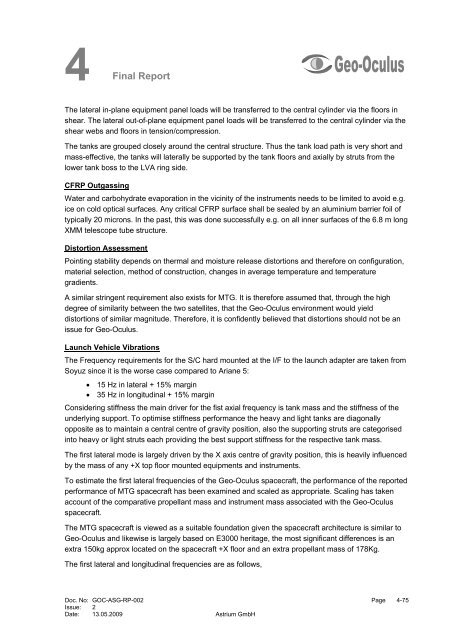4 Final Report - Emits - ESA
4 Final Report - Emits - ESA
4 Final Report - Emits - ESA
Create successful ePaper yourself
Turn your PDF publications into a flip-book with our unique Google optimized e-Paper software.
4 <strong>Final</strong><br />
<strong>Report</strong><br />
The lateral in-plane equipment panel loads will be transferred to the central cylinder via the floors in<br />
shear. The lateral out-of-plane equipment panel loads will be transferred to the central cylinder via the<br />
shear webs and floors in tension/compression.<br />
The tanks are grouped closely around the central structure. Thus the tank load path is very short and<br />
mass-effective, the tanks will laterally be supported by the tank floors and axially by struts from the<br />
lower tank boss to the LVA ring side.<br />
CFRP Outgassing<br />
Water and carbohydrate evaporation in the vicinity of the instruments needs to be limited to avoid e.g.<br />
ice on cold optical surfaces. Any critical CFRP surface shall be sealed by an aluminium barrier foil of<br />
typically 20 microns. In the past, this was done successfully e.g. on all inner surfaces of the 6.8 m long<br />
XMM telescope tube structure.<br />
Distortion Assessment<br />
Pointing stability depends on thermal and moisture release distortions and therefore on configuration,<br />
material selection, method of construction, changes in average temperature and temperature<br />
gradients.<br />
A similar stringent requirement also exists for MTG. It is therefore assumed that, through the high<br />
degree of similarity between the two satellites, that the Geo-Oculus environment would yield<br />
distortions of similar magnitude. Therefore, it is confidently believed that distortions should not be an<br />
issue for Geo-Oculus.<br />
Launch Vehicle Vibrations<br />
The Frequency requirements for the S/C hard mounted at the I/F to the launch adapter are taken from<br />
Soyuz since it is the worse case compared to Ariane 5:<br />
• 15 Hz in lateral + 15% margin<br />
• 35 Hz in longitudinal + 15% margin<br />
Considering stiffness the main driver for the fist axial frequency is tank mass and the stiffness of the<br />
underlying support. To optimise stiffness performance the heavy and light tanks are diagonally<br />
opposite as to maintain a central centre of gravity position, also the supporting struts are categorised<br />
into heavy or light struts each providing the best support stiffness for the respective tank mass.<br />
The first lateral mode is largely driven by the X axis centre of gravity position, this is heavily influenced<br />
by the mass of any +X top floor mounted equipments and instruments.<br />
To estimate the first lateral frequencies of the Geo-Oculus spacecraft, the performance of the reported<br />
performance of MTG spacecraft has been examined and scaled as appropriate. Scaling has taken<br />
account of the comparative propellant mass and instrument mass associated with the Geo-Oculus<br />
spacecraft.<br />
The MTG spacecraft is viewed as a suitable foundation given the spacecraft architecture is similar to<br />
Geo-Oculus and likewise is largely based on E3000 heritage, the most significant differences is an<br />
extra 150kg approx located on the spacecraft +X floor and an extra propellant mass of 178Kg.<br />
The first lateral and longitudinal frequencies are as follows,<br />
Doc. No: GOC-ASG-RP-002 Page 4-75<br />
Issue: 2<br />
Date: 13.05.2009 Astrium GmbH

















